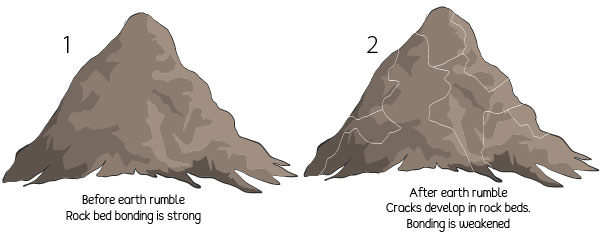- Landslides and Mudslides
Causes of landslides
Landslides are caused by these three main events—
Slopes saturated by water:
Intense rainfall, snowmelt, and seepage often leave land surfaces saturated. Flooding results and water overflowing its channels often wipe out land surfaces to cause mudflows.
Seismic activity:
Earth tremors, earthquakes, and natural seismic activity that cause the earth to rumble or shake (vibrations) can weaken the bonding of bedrock and expose the earth to landslides.
 Volcanic activity:
Volcanic activity:
Lava from eruptions has the potential of melting snow at here high rates. A combination of melted snow, debris, volcanic ash, and soils flowing rapidly along a slope can result in catastrophic landslides.
Geological:
Weathered rock, sheared, fissured, or jointed rock material are known causes of landslides. Contrasting earth material and low adhesiveness of the rock also cause landslides. It is so because cohesive rock material often holds itself in place and are less prone to weathering and movement.
Morphological:
All forms of erosion, such as fluvial, water, wave, glacial along a slope may cause landslides and other types of flows. Deposition from erosion may also cause a build-up of earth material (or debris) at places that may eventually give way in the form of landslides. Weathering is also a major cause of landslides. It is a powerful process of weakening debris and earth material on the surface of the slope.
Human:
Activities such as mining, construction, farming, deforestation, irrigation, reservoirs and dams, and the like, all contribute to exposing the surface of the earth and causing landslides. For example, in many mining communities along slopes, tunnels and deep wells are dug into the ground and often left unfilled. With time, air and water get in and may result in the earth giving way. Such activities also expose lands to weathering and massive erosion that all end up causing some types of landslides.
